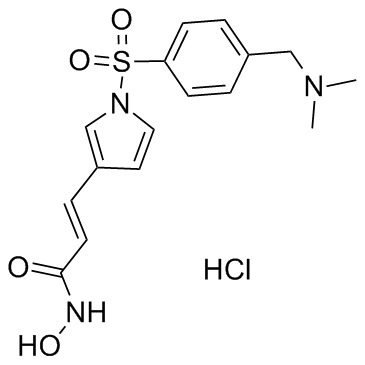Resminostat hydrochloride
Modify Date: 2024-01-11 07:13:06

Resminostat hydrochloride structure
|
Common Name | Resminostat hydrochloride | ||
|---|---|---|---|---|
| CAS Number | 1187075-34-8 | Molecular Weight | 385.86600 | |
| Density | N/A | Boiling Point | N/A | |
| Molecular Formula | C16H20ClN3O4S | Melting Point | N/A | |
| MSDS | N/A | Flash Point | N/A | |
Use of Resminostat hydrochlorideResminostat hydrochloride is a potent inhibitor of HDAC1, HDAC3 and HDAC6, with mean IC50 values of 42.5, 50.1, 71.8 nM, respectively, and shows less potent activities against HDAC8, with an IC50 of 877 nM. |
| Name | (E)-3-[1-(4-dimethylaminomethyl-benzenesulfonyl)-1H-pyrrol-3-yl]N-hydroxy-acrylamide hydrochloride |
|---|---|
| Synonym | More Synonyms |
| Description | Resminostat hydrochloride is a potent inhibitor of HDAC1, HDAC3 and HDAC6, with mean IC50 values of 42.5, 50.1, 71.8 nM, respectively, and shows less potent activities against HDAC8, with an IC50 of 877 nM. |
|---|---|
| Related Catalog | |
| Target |
HDAC1:42.5 nM (IC50) HDAC3:50.1 nM (IC50) HDAC6:71.8 nM (IC50) HDAC8:877 nM (IC50) |
| In Vitro | Resminostat hydrochloride (Resminostat [HCl], 5 μM) induces histone acetylation in myeloma cells. Resminostat hydrochloride displays a substrate competitive binding mode with a mean Ki value of 27 nM. Resminostat hydrochloride (5 μM) induces histone hyperacetylation in myeloma cells. Resminostat inhibits cell growth, induces apoptosis and inhibits MM cell proliferation. Resminostat (5 μM) also modulates expression of bcl-2 family proteins and inhibits Akt pathway signalling downstream of Akt. Resminostat exerts synergistic activity against myeloma cells when combined with common and new anti-myeloma agents[1]. Resminostat inhibits cell growth in head and neck squamous cell carcinoma cell lines, with IC50s ranging from 0.775 μM to 1.572 μM (IC50 for SCC25: 0.775 μM; CAL27: 1.572 μM; and FaDu: 0.899 μM). Resminostat (1.25 and 2.5 μM) has a synergistic effect with irradiation on HNSCC cell lines. Resminostat in combination with cisplatin induces a downregulation of survivin. However, Resminostat shows no effect on Mcl-1 and p-AKT expression[2]. Resminostat reduces viability of HCC cells with the co-treatment of AZD-2014, with IC50s ranging from 0.89 ± 0.12 μM to 0.07 ± 0.01 μM[3]. |
| Kinase Assay | Forty microliter enzyme buffer (15 mM Tris HCl pH 8.1, 0.25 mM EDTA, 250 mM NaCl, 10% v:v glycerol) containing HDAC1, 3, 6 or 8 activity, 29 μL enzyme buffer and 1 μL resminostat [HCl] at different concentrations are added to a 96-well microtitre plate and the reaction started by the addition of 30 μL substrate peptide Ac-NH-GGK(Ac)-AMC (HDAC1, 3 and 6 assays, final concentrations 6 μM for HDAC1, 10 μM for HDAC6 and 25 μM for HDAC3/DAD) or Ac-RHK(Ac)K(Ac)-AMC (HDAC8 assay, final concentration 50 μM). After incubation for 180 min (HDAC1, HDAC6, HDAC8) or 120 min (HDAC3) at 30°C, the reaction is terminated by the addition of 25 μL stop solution (50 mM Tris HCl pH 8, 100 mM NaCl, 0.5 mg/mL trypsin and 2 μM trichostatin A [TSA]). After incubation at room temperature for further 40 min, fluorescence is measured using a Wallac Victor2 1420 multilabel counter (extinction 355 nm, emission 460 nm) for quantification of AMC generated by tryptic cleavage of the deacetylated peptide. For the calculation of the 50% inhibitory concentration (IC50) values the fluorescence in wells without test compound (1% DMSO, negative control) is set as 100% enzymatic activity and the fluorescence in wells with 2 μM TSA (positive control) are set at 0% enzymatic activity (background fluorescence substracted)[1]. |
| Cell Assay | A CCK-8 cell proliferation assay is used to investigate the antiproliferative effect of resminostat on HNSCC cells. Cells are seeded into 96-well plates at a density of 3 × 105/well. After 24 hours of growth, the cells are treated with resminostat and cisplatin, either alone or in combination and incubated for 72 hours. Untreated cells maintained in RPMI and equal concentrations of dimethylsulfoxide served as control. After 72 hours, cell proliferation is measured by CCK-8. Experiments are carried out in triplicate 3 times[2]. |
| References |
| Molecular Formula | C16H20ClN3O4S |
|---|---|
| Molecular Weight | 385.86600 |
| Exact Mass | 385.08600 |
| PSA | 100.02000 |
| LogP | 3.57900 |
| Storage condition | 2-8℃ |
| (E)-3-[1-(4-dimethylaminomethylbenzenesulfonyl)-1H-pyrrol-3-yl]N-hydroxyacrylamide hydrochloride |
| Resminostat Hydrochloride |